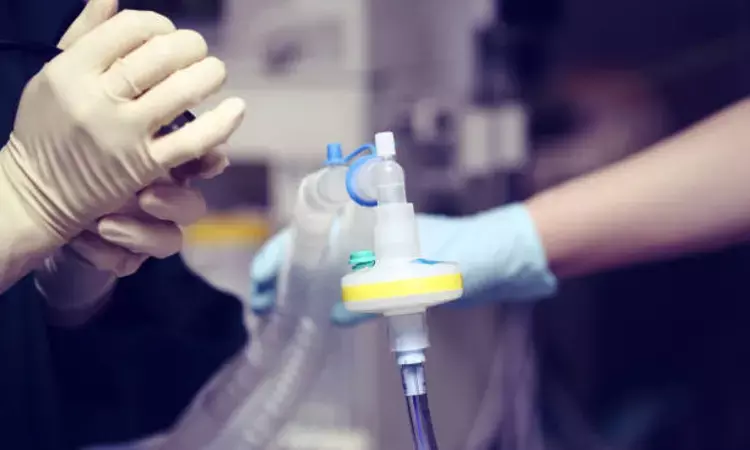- Home
- Medical news & Guidelines
- Anesthesiology
- Cardiology and CTVS
- Critical Care
- Dentistry
- Dermatology
- Diabetes and Endocrinology
- ENT
- Gastroenterology
- Medicine
- Nephrology
- Neurology
- Obstretics-Gynaecology
- Oncology
- Ophthalmology
- Orthopaedics
- Pediatrics-Neonatology
- Psychiatry
- Pulmonology
- Radiology
- Surgery
- Urology
- Laboratory Medicine
- Diet
- Nursing
- Paramedical
- Physiotherapy
- Health news
- Fact Check
- Bone Health Fact Check
- Brain Health Fact Check
- Cancer Related Fact Check
- Child Care Fact Check
- Dental and oral health fact check
- Diabetes and metabolic health fact check
- Diet and Nutrition Fact Check
- Eye and ENT Care Fact Check
- Fitness fact check
- Gut health fact check
- Heart health fact check
- Kidney health fact check
- Medical education fact check
- Men's health fact check
- Respiratory fact check
- Skin and hair care fact check
- Vaccine and Immunization fact check
- Women's health fact check
- AYUSH
- State News
- Andaman and Nicobar Islands
- Andhra Pradesh
- Arunachal Pradesh
- Assam
- Bihar
- Chandigarh
- Chattisgarh
- Dadra and Nagar Haveli
- Daman and Diu
- Delhi
- Goa
- Gujarat
- Haryana
- Himachal Pradesh
- Jammu & Kashmir
- Jharkhand
- Karnataka
- Kerala
- Ladakh
- Lakshadweep
- Madhya Pradesh
- Maharashtra
- Manipur
- Meghalaya
- Mizoram
- Nagaland
- Odisha
- Puducherry
- Punjab
- Rajasthan
- Sikkim
- Tamil Nadu
- Telangana
- Tripura
- Uttar Pradesh
- Uttrakhand
- West Bengal
- Medical Education
- Industry
Optimizing One-Lung Ventilation: Prostaglandin E1 Advantage in Oxygenation and Safety, suggests study

In a recent study investigating the effects of prostaglandin E1 (PGE1) on reducing inspired oxygen concentration during one-lung ventilation (OLV), several key findings and outcomes were identified. The study included 120 patients undergoing thoracic surgery, randomly assigned to four groups receiving different FiO2 levels and PGE1 nebulization. The primary outcome was oxygenation during OLV, with secondary outcomes including inflammatory markers, postoperative complications, and hospital stay duration.
Results and Impacts of PGE1 Administration
The results showed that pre-OLV nebulization of PGE1 reduced the required FiO2 during OLV, leading to improved oxygenation and lower incidence of hypoxemia. The nebulized PGE1 groups exhibited delayed decreases in PaO2 and improvements in PaO2/FiO2 ratio compared to the control group. Furthermore, PGE1 inhalation resulted in lower Qs/Qt, reduced inflammatory cytokine levels, and improved clinical pulmonary infection scores. The study concluded that the combined impact of reduced FiO2 and PGE1 administration decreased the risk of hypoxemia and systemic inflammatory responses during OLV.
Importance of Lung Protection and Oxygenation Management
Additionally, the study highlighted the importance of lung protection and oxygenation management during OLV. Clear guidelines on optimal FiO2 levels during OLV are currently lacking, emphasizing the need for strategies to minimize oxidative stress while ensuring adequate oxygenation. The study findings supported the use of PGE1 to optimize oxygenation and reduce systemic inflammation by lowering FiO2 requirements during OLV.
Study Limitations and Recommendations for Further Research
However, the study also identified limitations that warrant further investigation. These include the need for larger sample sizes focused on postoperative complications, exploration of different PGE1 doses, and validation in populations with impaired lung function. Future studies should aim to explore long-term outcomes, diverse PGE1 doses, and the applicability of the recommended regimen across various patient populations.
Conclusive Findings on PGE1 Administration
In conclusion, the study demonstrated that pre-OLV PGE1 administration reduces the required FiO2 during OLV, leading to improved oxygenation, decreased hypoxemia risk, and lowered systemic inflammatory responses. This approach holds promise for optimizing patient outcomes during thoracic surgery by balancing oxygenation needs and minimizing oxidative stress-related complications associated with high FiO2 levels.
Key Points
- Pre-OLV nebulization of prostaglandin E1 (PGE1) reduced the needed FiO2 during one-lung ventilation (OLV), enhancing oxygenation and decreasing hypoxemia.
- Patients receiving PGE1 showed delayed decreases in PaO2, improved PaO2/FiO2 ratio, lower Qs/Qt values, reduced inflammatory cytokine levels, and better clinical pulmonary infection scores.
- Lung protection and oxygenation management during OLV are crucial, with the study underlining the lack of clear guidelines on optimal FiO2 levels.
- The study suggests that PGE1 administration can optimize oxygenation, lower systemic inflammation, and diminish hypoxemia risk by reducing FiO2 requirements during OLV.
- Study limitations include the need for larger sample sizes, exploration of different PGE1 doses, and validation in populations with impaired lung function.
- Conclusively, PGE1 administration pre-OLV holds promise in enhancing patient outcomes during thoracic surgery by balancing oxygenation requirements and minimizing complications related to high FiO2 levels.
Reference –
Lingxi Xing et al. (2025). The Impact Of Different Inspired Oxygen Concentrations Combined With Nebulized Prostaglandin E1 On Oxygenation In Patients Undergoing One-Lung Ventilation: A Randomized Controlled Trial. *BMC Anesthesiology*, 25. https://doi.org/10.1186/s12871-025-03081-3.
MBBS, MD (Anaesthesiology), FNB (Cardiac Anaesthesiology)
Dr Monish Raut is a practicing Cardiac Anesthesiologist. He completed his MBBS at Government Medical College, Nagpur, and pursued his MD in Anesthesiology at BJ Medical College, Pune. Further specializing in Cardiac Anesthesiology, Dr Raut earned his FNB in Cardiac Anesthesiology from Sir Ganga Ram Hospital, Delhi.


